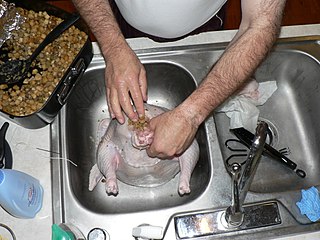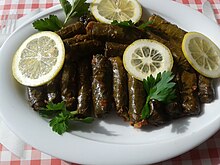
Turkish cuisine is the cuisine of Turkey and the Turkish diaspora. Although the cuisine took its current rich form after numerous cultural interactions throughout centuries, it should not be confused with other cuisines such as Ottoman cuisine or Seljuk cuisine. Turkish cuisine with traditional Turkic elements such as yogurt, ayran, kaymak, exerts and gains influences to and from Mediterranean, Balkan, Middle Eastern, Central Asian and Eastern European cuisines.

Stuffing, filling, or dressing is an edible mixture, often composed of herbs and a starch such as bread, used to fill a cavity in the preparation of another food item. Many foods may be stuffed, including poultry, seafood, and vegetables. As a cooking technique stuffing helps retain moisture, while the mixture itself serves to augment and absorb flavors during its preparation.

Polish cuisine is a style of food preparation originating in and widely popular in Poland. Due to Poland's history, Polish cuisine has evolved over the centuries to be very eclectic, and shares many similarities with other national cuisines. Polish cooking in other cultures is often referred to as à la polonaise.

Dolma is a family of stuffed dishes associated with Turkish or Ottoman cuisine, typically made with a filling of rice, minced meat, offal, seafood, fruit, or any combination of these inside a vegetable or a leaf wrapping. Wrapped dolma, specifically, are known as sarma, made by rolling grape, cabbage, or other leaves around the filling. Dolma can be served warm or at room temperature and are common in modern cuisines of regions and nations that once were part of the Ottoman Empire.

Ukrainian cuisine is the collection of the various cooking traditions of the people of Ukraine, one of the largest and most populous European countries. It is heavily influenced by the rich dark soil (chornozem) from which its ingredients come, and often involves many components. Traditional Ukrainian dishes often experience a complex heating process – "at first they are fried or boiled, and then stewed or baked. This is the most distinctive feature of Ukrainian cuisine".

A cabbage roll is a dish consisting of cooked cabbage leaves wrapped around a variety of fillings. It is common to the cuisines of Central, Northern, Eastern and Southeastern Europe and much of Western Asia, Northern China, as well as parts of North Africa. Meat fillings are traditional in Europe, and include beef, lamb, or pork seasoned with garlic, onion, and spices. Grains such as rice and barley, mushrooms, and vegetables are often included as well. Fermented cabbage leaves are used for wrapping, particularly in southeastern Europe. In Asia, seafoods, tofu, and shiitake mushrooms or Vegeta may also be used. Chinese cabbage is often used as a wrapping.
Romanian cuisine is a diverse blend of different dishes from several traditions with which it has come into contact, but it also maintains its own character. It has been mainly influenced by Turkish but also a series of European cuisines in particular from the Balkan Peninsula and Hungarian cuisine as well as culinary elements stemming from the cuisines of Central Europe.

Grape leaves, the leaves of the grapevine plant, are used in the cuisines of a number of cultures. They may be obtained fresh, or preserved in jars or cans. The leaves are commonly rolled or stuffed with mixtures of meat and rice to produce dolma, found widely in the Mediterranean, Caucasus, Balkans, and Middle East. They may also be used in various other recipes and dishes. When cut into smaller pieces they are used as a savory addition to soups that include greens and cabbage.

Iraqi cuisine is a Middle Eastern cuisine that has its origins in the ancient Near East culture of the fertile crescent. Tablets found in ancient ruins in Iraq show recipes prepared in the temples during religious festivals—the first cookbooks in the world. Ancient Mesopotamia was home to a sophisticated and highly advanced civilization, in all fields of knowledge, including the culinary arts.

Czech cuisine has both influenced and been influenced by the cuisines of surrounding countries and nations. Many of the cakes and pastries that are popular in Central Europe originated within the Czech lands. Contemporary Czech cuisine is more meat-based than in previous periods; the current abundance of farmable meat has enriched its presence in regional cuisine. Traditionally, meat has been reserved for once-weekly consumption, typically on weekends.
Bosnian cuisine is the traditional cuisine of Bosnia and Herzegovina. It is influenced by Ottoman, Austro-Hungarian and Balkan cuisines.

Holishkes is cabbage roll dish adapted from the traditional Slavic cuisine by European Jews. Holishkes are prepared from blanched cabbage leaves wrapped in a parcel-like manner around minced meat and then simmered in tomato sauce. Sometimes rice is added to the meat filling. While the dish is eaten all year round, it is customarily served on Sukkot to symbolize a bountiful harvest, and on Simchat Torah because two stuffed cabbage rolls placed side by side resemble Torah scrolls.

Stuffed peppers is a dish common in many cuisines. It consists of hollowed or halved bell peppers filled with any of a variety of fillings, often including meat, vegetables, cheese, rice, or sauce. The dish is usually assembled by filling the cavities of the peppers and then cooking.
The cuisine of Kosovo is a representative of the cuisine of the Balkans and consists of traditional dishes by ethnic groups native to Kosovo. Due to ethnic connections with Albania, it has been significantly influenced by Albanian cuisine and has adopted elements of other Balkan countries.

Moldovan cuisine is a style of cooking related to the people of Moldova. It consists mainly of ingredients such as various meats, potatoes, cabbage, and a variety of cereal grains. The local cuisine is very similar to Romanian, and also draws inspiration and elements from other cuisines in the region, including Greek, Polish, Ukrainian, and Russian, with a great influence left by the Ottoman cuisine.

The Crimean Tatar cuisine is primarily the cuisine of the Crimean Tatars, who live on the Crimean Peninsula. The traditional cuisine of the Crimean Tatars has similarities with that of Greeks, Italians, Balkan peoples, Nogais, North Caucasians, and Volga Tatars, although some national dishes and dietary habits vary between different Crimean Tatar regional subgroups; for example, fish and produce are more popular among Yaliboylu and Tat dishes while meat and dairy is more prevalent in Steppe Tatar cuisine. Many Uzbek dishes were incorporated into Crimean Tatar national cuisine during exile in Central Asia since 1944, and these dishes have become prevalent in Crimea since the return. Uzbek samsa, laghman, and plov (pilaf) are sold in most Tatar roadside cafes in Crimea as national dishes. In turn, some Crimean Tatar dishes, including Chiburekki, have been adopted by peoples outside Crimea, such as in Turkey and the North Caucasus.

Stuffed tomatoes are one of a number of dishes in which tomatoes are filled with ingredients, usually including rice. In 2017, dolma making in Azerbaijan was included in the UNESCO Intangible Cultural Heritage Lists.


















